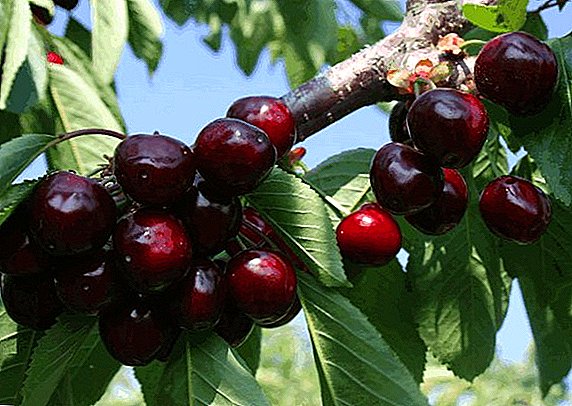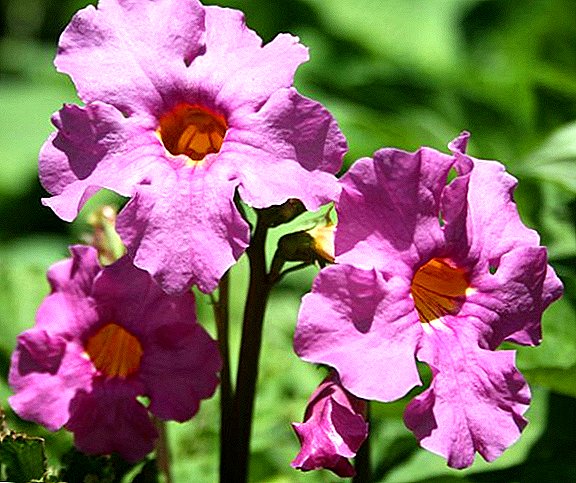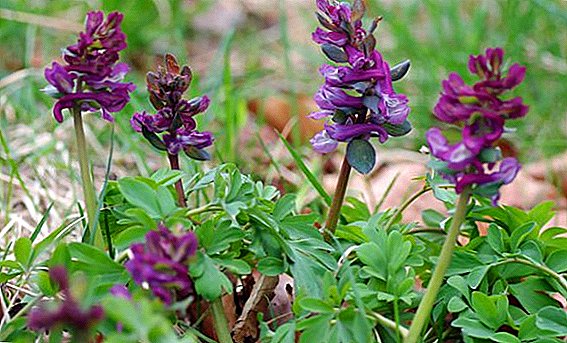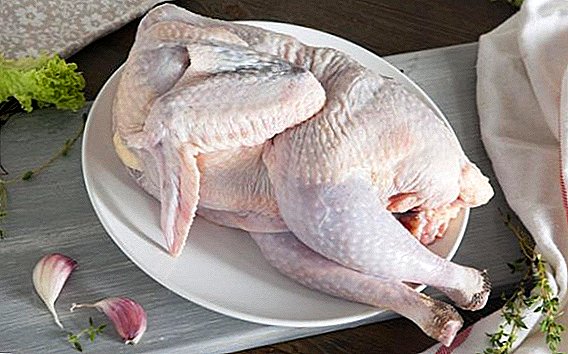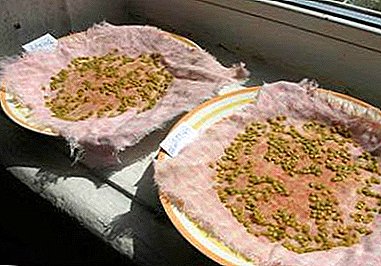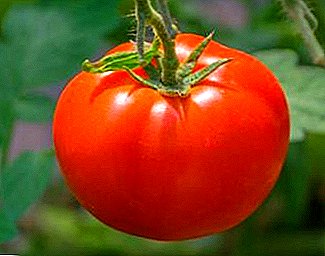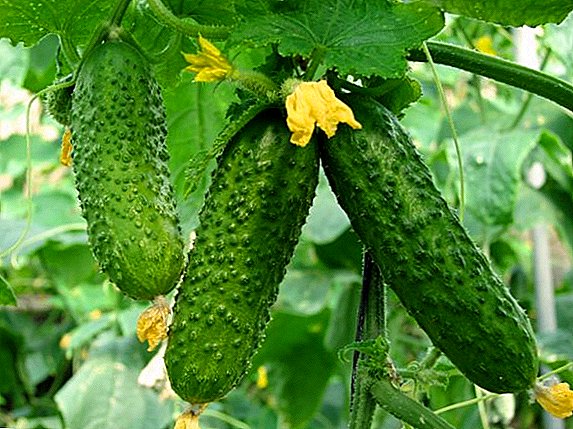 Gardeners often have to deal with the fact that their greenhouse cucumbers, which they cherish, affect diseases and pests. The situation, which is created indoors, assists the mass development of various diseases. The fight against these troubles is an integral part of the care of vegetable crops. Consider the disease of cucumbers in the greenhouse and describe the methods of their treatment, as well as provide photos that will help quickly recognize the "enemy". The sooner you find and identify a disease or pest, the more healthy and pristine crops you will receive.
Gardeners often have to deal with the fact that their greenhouse cucumbers, which they cherish, affect diseases and pests. The situation, which is created indoors, assists the mass development of various diseases. The fight against these troubles is an integral part of the care of vegetable crops. Consider the disease of cucumbers in the greenhouse and describe the methods of their treatment, as well as provide photos that will help quickly recognize the "enemy". The sooner you find and identify a disease or pest, the more healthy and pristine crops you will receive.
Causes of
Greenhouse cucumbers are more susceptible to fungal, bacterial and viral infections than vegetables grown in open ground. Prerequisites for the development of diseases and the spread of pests are the following factors:
- artificial microclimate (lack of optimal conditions necessary for normal development and growth);
- irregular temperature conditions (frequent and sudden temperature changes in the greenhouse);
- high humidity;
- cold water irrigation, excessive watering, frequent spraying of plants;
- the presence of drafts; lack of lighting; lack of nutrients in the ground;
- neglect of the principles of crop rotation (rare replacement of the site and soil for planting);
- planting seedlings in the ground, where the bad predecessors of cucumber (watermelon, melon, zucchini, squash, pumpkin) previously grew;
- irregular cleaning;
- late detection of affected plants.

Did you know? The first ever greenhouses for year-round cultivation of cucumber bushes were built in ancient Rome. The Roman emperor Tiberius (42 BC. AD-37 AD) wished to eat these vegetables every day.
The main diseases of greenhouse cucumbers and their treatment
The most common diseases affecting culture in greenhouse conditions are: anthracnose, powdery mildew, downy mildew, gray and white rot, bacteriosis, root rot. These and some other diseases of cucumbers, we now consider in detail, as well as provide a photo of infected leaves in each case.
Anthracnose
Anthracnose - a disease provoked by the fungus Colletotrichum lagenarium. The fungus actively multiplies throughout the vegetative phase. Recognize the disease on yellowish-brown round spots on sheets and cotyledons. Gradually, the affected parts of the leaves become brittle and crumble. On the shoots appear in-depth spots covered with pink-copper mucus. If the disease infects the fruit, then they also form indentations in the form of ulcers. In conditions of high humidity, these formations become covered with pink mold, and then turn black. 
The taste of vegetables becomes bitter, and during storage and transportation they rot. Eating such a vegetable is undesirable.
When identifying these signs, the affected fruit is better to immediately remove, and vines to process with 0.4% chlorine dioxide. You can also apply a 1% solution of Bordeaux mixture. The procedure is carried out once every 10 days.
Mealy dew
Powdery mildew (The mycelium is the causative agent of Erysiphales) is one of the most common diseases of cucumbers in protected ground. In infected plants, early dying off of the leaves is noted, and the yield is reduced. At the initial stage of the disease can be identified by a light whitish on the foliage. Gradually, the spots increase, powdery mildew spreads to the stalks and stalks, and the leaves turn brown and die. 
If you find signs of powdery mildew, remove the affected parts of plants at the source of infection, then treat the bushes with sulfur-based fungicides (Topsin, Bayleton, Tiovit Jet, Caratan, colloidal sulfur). A good result also gives mullein infusion. Re-processing is carried out only after 1-2 weeks.
Important! Sources of fungal infections should be searched near windows, heating pipes and greenhouse doors.
Perinosporosis (downy mildew)
Downy mildew or perinospora- a dangerous ailment caused by the fungus Plasmopara and affecting mainly foliage. Once on the plant, the perinospora mycelium rapidly develops, blocking the supply of nutrients. The mycelium may persist in cucumber seeds for many years. On the surface of the sheet, yellowish-brown spots first form. Over time, these ulcers expand and grow together. On the reverse side of the sheet there is a thick gray-purple bloom. Foliage dries, wrinkles and falls. 
To overcome the disease, stop watering, sprinkle the soil with wood ash. Cover the vines well at night and air them during the day. Spray the solution of Phytosporin. Leaves on both sides carefully process Bordeaux mixture or copper-soap emulsion.
As popular methods used kefir with iodine or sour milk.
Gray rot
Gray rot - infection resulting from the defeat of the bushes with Botrytis cinerea mycelium. Mycelium infects the ovaries, leaves, flowers and the fruits of the cucumber. Infection is characterized by the appearance of slippery gray formations on fruits, which can then grow together. 
Parts of plants infected with white rot need to be removed, capturing a part of a healthy shoot. Places cut with lime, copper sulfate or crushed coal.
With a weak infection treatment can be Bordeaux mixture. In the case of the appearance of rot on the bushes, professionals practice spraying fungicides. The following drugs are used: "Rovral", "Khom", "Profit", "Fundazol", "Ditan M-45", "Ordan", "Skor".
White rot
White rot or sclerotinia (Botrytis cinerea mycelium is the causative agent) is a common infection that infects most vegetable crops in greenhouse conditions. Substances secreted by the mycelium, destroy plant cells, resulting in young bushes die. The infection completely infects a cucumber plant: cuttings, shoots, leaves and fruits of cucumbers are damaged. 
The symptom of sclerotinia is a white and fluffy patina, resembling cotton wool. The plaque softens over time and turns into mucus. The affected tissues turn black and rot.
Control measures are similar to the procedures used to eradicate gray rot. However, in this case, in addition, dusting of the shoots and leaves with copper-chalk powder should be carried out. The event is carried out at the initial stage of development of the fungus.
Bacteriosis
Bacteriosis or angular spotting - Ailment caused by the harmful fungus Pseudomonas lachrymans. Initially, small light-brown ulcers are found on the cotyledons, and the foliage is covered with angular spots. Spots look soaked with water or oil. Later, infected tissues turn brown, dry out and disappear. The fruits are also possible manifestations of angular spotting: the cucumber looks like it was pecked by birds. 
When the first symptoms of bacteriosis appear on the leaves or cotyledons, first of all you need to get rid of infected plants or seedlings. Then immediately treat the bushes Bordeaux mixture or standard fungicides.
Root rot
Root rot - a dangerous disease of cucumbers, merciless both to young and old plants. Often the disease affects the weakened plants. Appearing in the basal area, this bacterium causes drying and death of the entire root system. As a result, the lower foliage turn yellow, and then the bush completely dies.
Shoots show weak growth. There is a high percentage of death of sprouts. In infected seedlings, brown spots are infused on the root collar, which rapidly multiply. Over time, the shoot becomes thinner, and the young leaves wither. Saplings easily break out of the soil. The disease is easy to recognize even on the leaves. They are deformed and covered with small brown spots. 
To overcome root rot, the plants are treated with the following biopreparations: Trichodermin, Pseudobacterin-2, and Baktofit.
Important! All of the above drugs use as directed in the instructions.
Greenhouse pest control
Along with diseases, your greenhouse cucumbers can attack some insect-parasites. Cucumber vines are more often affected by aphids, whitefly and spider mites. In the fight against every pest has its own nuances. Next, we will study this small pests of cucumbers, get acquainted with the symptoms, as well as photos of fruit lesions, and analyze their methods of treatment.
Gourd Aphid

The colony melon aphidfeed on plant sap, depleting them and spreading various viruses. The body length of the harmful insect is 2 mm. Color black or dark green. These small pests can quickly fill the bushes in a short time, and destroy the crop. First, the stems and leaves shrivel, and then die.
You can watch melon aphids on the back of the leaves and on the shoots of cucumber plants in July and August. Sources of aphids on cucumbers in greenhouse conditions are weeds, so you need to get rid of them in a timely manner. An infusion of red pepper and tobacco dust (30 g pepper and 200 g tobacco dust pour 10 liters of hot water) is considered to be quite effective in combating aphids in the greenhouse. Insist preparation about a day, strain, then make 1 tbsp. l liquid households soap and 3 tbsp. l wood resin. A week after the primary spraying procedure must be repeated. Try also to process the path between the rows in the greenhouse. As regards chemical preparations, the use of Strela or Inter-vir is practiced.
Whitefly greenhouse
White fly - harmful insect, often settling on greenhouse plants. This small pest has wings of white color, and its body is covered with white wax coating. The whitefly is capable of completely destroying the plant in a short time. She settles on the leaves of cucumbers, sucking the juice out of them and highlighting the sugary substance. Especially a lot of clusters are observed on the bottom of the sheet. Then the shoots and leaves turn black and die. 
Against the whitefly, effective treatment with the Akofit biological product (0.2%). The procedure is carried out 2-3 times during the entire vegetation phase.
Important! Never add fresh sawdust to the cucumber soil in the greenhouse. Sawdust takes calcium from the soil and depletes it. Use only sawdust that has lain for at least 1 year.To protect the greenhouse from the whitefly, cover all the doors and vents in one gauze layer. Then install special glue traps. To this end, pieces of plywood need to be painted in a white or yellow color attractive for the whitefly. Then grease the plywood with a mixture of rosin, castor oil and petroleum jelly.
A well-proven method of spraying leaves with clean water. After washing, sawdust, peat or humus should be added to the soil.
In the fight with the whitefly on cucumbers use cow, pork, sheep, horse and rabbit humus.
Spider mite


Greenhouse cucumbers are often affected. spider mite. With each increase in air temperature (from 20 ° C and above), the number of ticks increases. The pest eats both seedlings and adult vines. The arrival of the spider mite is easily determined: on the leaves you can observe the web, on which the mites move.
Against the spider mite, there are special drugs called acaricides. However, this parasite is prone to addiction to pesticides, therefore, funds must be periodically replaced with new ones. Clipper, Fitoverm, Bicol, Talstar, Akarin and others should be mentioned as effective.
Did you know? Fight against spider mite - no easy task. First you need to get rid of the female. The duration of her life is no more than a month, however, during this period the female has time to lay several hundred eggs. It is also known that a female of one species of mite is capable of laying 15-20 thousand eggs in its lifetime. Few among the animal world can boast of such productivity.
Prevention
Preventively carry out preventive measures that will prevent the emergence and spread of various diseases and pests on cucumbers in greenhouse conditions. Preventive measures are as follows:
- regular removal and destruction of infected, withered parts of plants, as well as rotten fruit;
- disinfection of the entire greenhouse, including soil, tools and other equipment;
- maintaining a favorable microclimate (temperature - 23-25 ° C, air humidity - 80-85%);
- moderate watering of the soil;
- maintaining crop rotation (periodically changing crops);
- sowing infection-resistant varieties and hybrids;
- heating and dressing the seed (for disinfection, seeds should be soaked in a 1% solution of potassium permanganate before sowing);
- landing in pre-prepared and heated soil;
- periodic processing of nutrients;
- regular airing of the room; Keeping beds clean.
We hope that this material will help you successfully deal with various misfortunes of greenhouse cucumbers and get a generous harvest. Proper care of cucumbers, timely prevention will reduce to almost zero the likelihood of the destruction of cucumbers diseases and pests.


